The Fox Trot in Guatemala: Cosmopolitan Nationalism among Ladinos
In 2007, Smithsonian Folkways released a recording entitled Chapinlandia: Marimba Music of Guatemala. Its liner notes open with a quotation by Erick Vargas, a performer in the ensemble Chapinlandia:
The importance of our marimba is that it reflects our identity, what we Guatemalans are. Our marimba has the capacity of being able to express the states of mind of the Guatemalan… When we are sad we play a very melancholic son… and when we are happy we play a seis por ocho, or a guarimba, or a cumbia, or a merengue on a marimba... [we] sometimes laugh and sometimes cry, and sometimes we do that on the instrument.” (Liner notes, Chapinlandia 2007:3)
Note that although marimba music “reflects our identity,” few of the genres mentioned by Vargas, and those represented in this recording, originated in Guatemala.1 Still, this selection of guarachas, corridos, boleros, waltzes, blues, and fox trots, represents a significant portion of Guatemalan marimba music. When I recently asked members of the marimba ensemble Teclas de Oro about their repertoire, they gave me a list of 113 pieces in which genres of foreign origins predominate (Table 1). The prevalence of imported genres in Guatemalan music also extends beyond marimba repertoire. Music historian Igor de Gandarias notes that fox trot, waltzes, Mazurkas, nocturnes, and paso doble comprise most of the national piano literature.2 While these genres did not originate within national borders, many of their local expressions suggest a Guatemalan identity through titular references. For example, the fox trot "Cobán," featured in Chapinlandia, is named after the capital of the department of Alta Verapaz in central Guatemala. "Ferrocarril de Los Altos" (Railroad to Los Altos) refers to the highlands in the western part of Guatemala, particularly the department of Quetzaltenango. Similarly, "Tristezas Quetzaltecas" (Saddness of Quetzaltenango) makes references to the same place. Another popular fox trot also featured on the Smithsonian CD, "Río Polochic," refers to the river in eastern Guatemala that flows into Lake Izabal.3 Not coincidentally, the fox trot appears as the predominant twentieth-century genre in the Chapinlandia album, in Gandarias’ survey, and in the repertoire of Teclas de Oro.
Table 1: Marimba Teclas de Oro Non-Comprehensive Repertoire
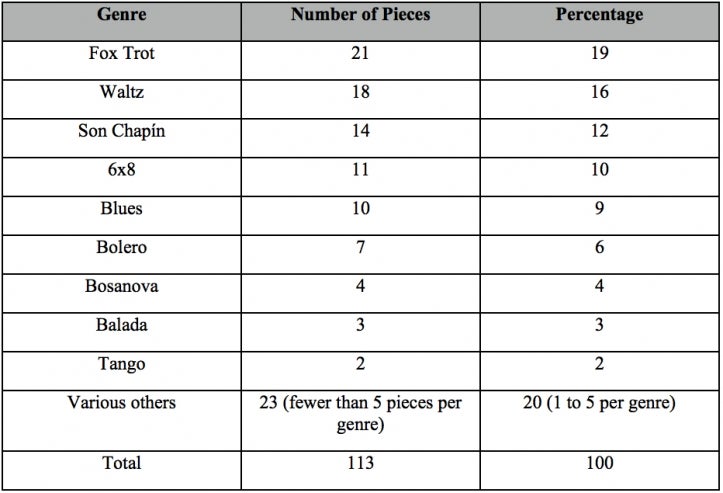
In this paper, I explore how foreign genres, particularly the fox trot, came to occupy such an important position in Guatemalan repertoire. Through archival materials, ethnographic data, and musical analysis, I show that cosmopolitanism constitutes a significant component of musical nationalism among Guatemalan ladinos (non-Mayas).4 I argue that Guatemalan cosmopolitanism embraces the discourse of modernity, which Turino (2000), Castro-Gómez (2005), and others have characterized as a transnational ideological, totalizing, and Eurocentric mediation of temporal relationships that discriminates against the “traditional”—which is cast as passé, simple, and primitive—to claim the present European and U.S. cultures as the apex of civilization.5 Instead of providing a close analysis of all the materials I engage in this paper, my goal is to spotlight particular cases that foreground cosmopolitan nationalism among Guatemalan ladinos, which I will continue to explicate in future work.6 I first discuss how the fox trot engages with modernity through references to technology and alterity in the early twentieth century. I then reflect on the professional trajectory of the marimba ensembles of the Hurtado Brothers to highlight how transnational and nationalist discourses intersect in Guatemalan marimba music. Finally, I discuss how the fox trot underscores an ironic tension between cosmopolitan sensibilities and musical nationalism in contemporary Guatemala.
The Fox Trot in Early 20th Century Guatemala: Modernity, Alterity, and Cosmopolitanism
Turino describes cosmopolitanism as a translocal discourse that connects various locales through specific types of loops (media, contacts, interchanges) and a similar habitus (Turino 2000:9-10). Given specific historical, geographical, and ideological contexts, cosmopolitanism can take different forms. “Modernist-capitalist” cosmopolitanism is its most common (ibid.). Fox trots from a collection of scores housed in the Museo Carlos Mérida in Guatemala City suggest that Guatemala’s importation of this genre participates in the modernist-capitalist form of cosmopolitanism; they present an image of a “modern” Guatemala through references to technological advancement, and through constructions of alterity to which modernity sets itself in opposition.7
Among the fifty-six fox trots in this collection, modernity most explicitly appears through pieces that reference technology, for example “Entre las Nubes” and “Mar y Cielo.” Both of these fox trots call attention to the growth of aviation technology in early twentieth century Guatemala.
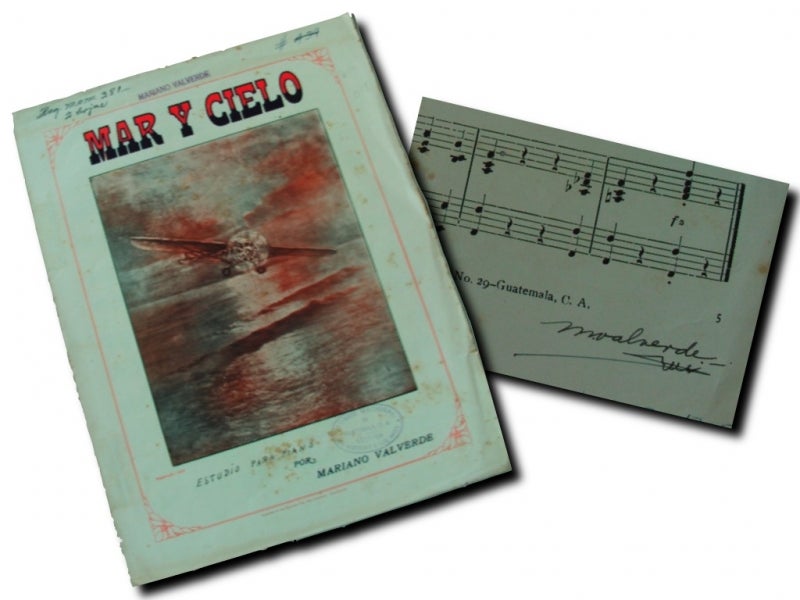
Figure 1: “Mar y Cielo” (Sea and Sky): Autographed Fox Trot by Mariano Valverde (1884-1956). [Photo by Andrés Amado, with permission of the Museo de Arte Moderno Carlos Mérida, Guatemala City].

Figure 2: “Entre Las Nubes” (Amid the Clouds): Fox Trot manuscript by Rafael Castellanos. The dedication below reads: “Dedicated to Guatemalan aviators, Miguel García Granados and Carlos Merlen.” [Photograph by Andrés Amado, with permission of the Museo de Arte Moderno Carlos Mérida].
Aviation, as did other technological developments of the time, facilitated important transnational interactions. In 1912, two Swiss pilots introduced Guatemala to aviation through exhibition flights that featured French aircrafts.8 In 1913, Dante Nannini Sandoval was the first Guatemalan national who traveled to the United States for aviation training (Quesada Fernández 2008:39). Two years later, he helped found the first military aviation academy in Guatemala (ibid.:59-67, 79-86). In 1929, Guatemalan president Lázaro Chacón González created the first civilian aviation academy.
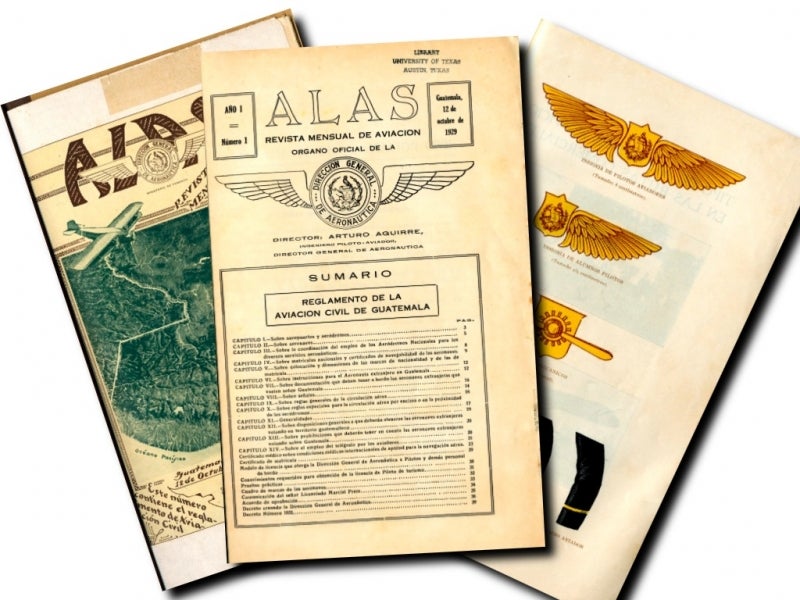
Figure 3: Excerpts from Alas: Revista Mensual de Aviación (Wings: Monthly Journal of Aviation). Issue 1, Volume 1 (1929).
The first issue of the journal Alas documents the opening of the academy, and provides valuable context for Guatemalan fox trots. Its cover includes a photograph of Rodríguez Díaz, who is featured as the subject of a fox trot.
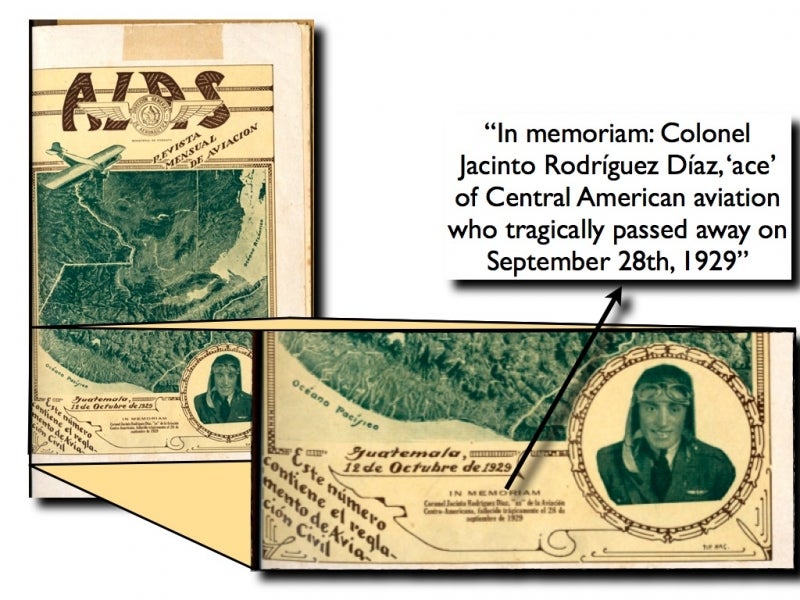
Figure 4: Detail from the cover of Alas.
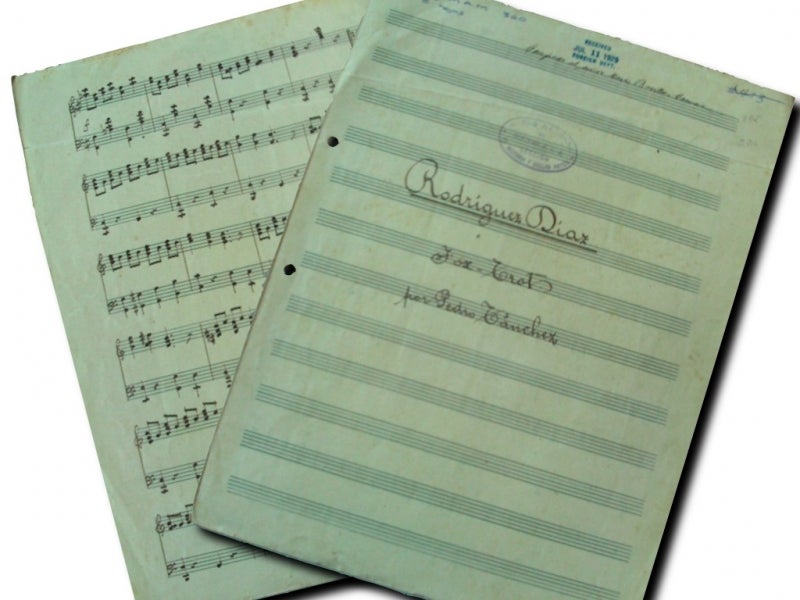
Figure 5: “Rodríguez Díaz: Fox Trot” by Pedro Tánchez. Manuscript, Museo de Arte Moderno Carlos Mérida. [Photo by Andrés Amado].
Alas also includes photographs of the aircrafts used in Guatemala, which resemble the plane on the cover of “Mar y Cielo” (Alas 1929:44).
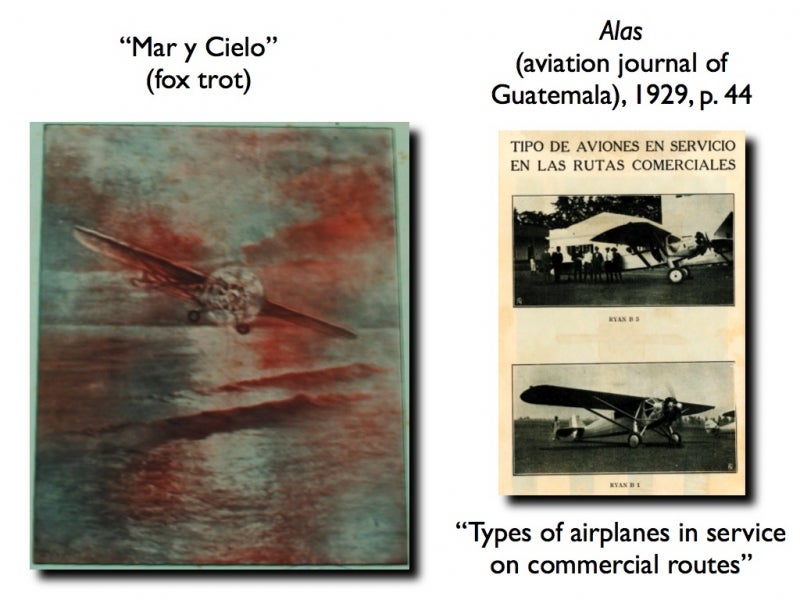
Figure 6: Aircrafts in “Mar y Cielo” correspond to those used in Guatemalan aviation in 1929 (Alas).9
The discourses of aviation, nationalism, and cosmopolitanism intersect. Aviators were celebrated as Guatemalan and Central American pioneers. They flew French machines and trained in the United States (Quesada Fernández 2008:33-35). Likewise, Guatemalan dignitaries used aviation as a means to promote a modern image of the country; for instance, Manuel Estrada Cabrera (president from 1898 to 1920) featured aviation at state events he institutionalized as “Fiestas de Minerva” (ibid.:81). Later, President Chacón González (president from 1926 to 1931) accorded diplomatic tasks and honors to the very aviators referenced in the fox trot “Entre las Nubes” (See Figure 2).10 The New York Times reported on July 31, 1929:
Bearing a good-will message to President Hoover from President Lazaro Chacon of Guatemala, Colonel Miguel Garcia Granados, chief of the Guatemalan Air Service, and his aide, Lieutenant Carlos Merlen, landed here at Bolling Field at 1:25 o’clock this afternoon, after a 2,832 mile flight from Guatemala City… Colonel Granados said his visit was intended to repay the visit of Colonel Charles A. Lindbergh to Guatemala during his Central American tour a year ago... Speaking through his aide, Lieutenant Merlen, Colonel Granados told the story of their... flight from the Guatemalan capital to Washington. He said the fliers were given a royal send-off by President Chacon, the American Minister Arthur H. Geissler, and hundreds of other officials and citizens.11
In addition to celebrating Guatemala’s technological advancement, fox trots also engaged with the nationalist discourse by articulating internal and external difference.
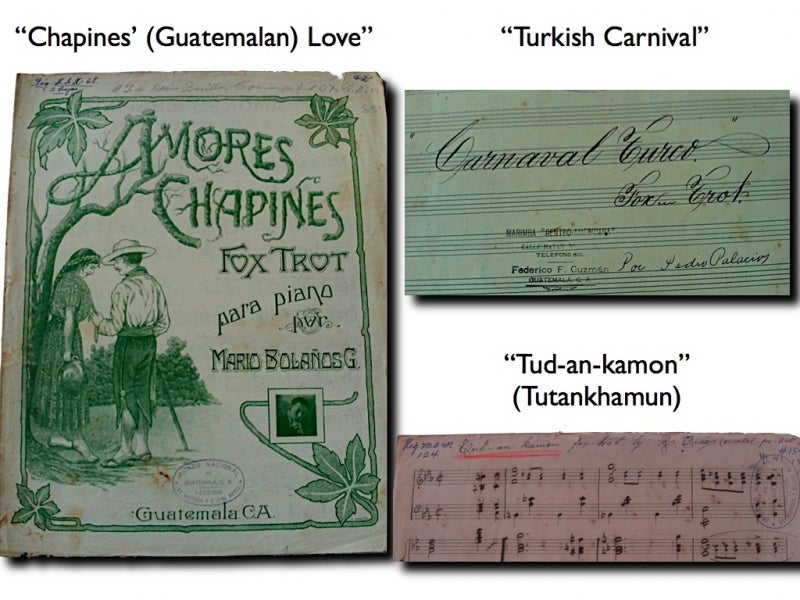
Figure 7: Guatemalan Fox Trots and Alterity. Scores from the Museo de Arte Moderno Carlos Mérida. [Photographed by Andrés Amado with permission].
Although I will not comment extensively on these images here, I note that these fox trots reflect elite exoticist and essentialist perspectives common to the modernist discourse in the United States and Europe; in this case, a romantic representation of local indigenous populations, as an internal Other tied to nature (the image of the tree and font of the title imitating branches) and tradition (through the woman's traditional indigenous attire). Additionally, many pieces like “Turkish Carnival” and “Tud-an-kamon” also refer to external and exotic Others. Such exoticist titles suggest that the racialization of the nationalist project through music merits further study.
Through references to technology, and through the essentialization of internal and external Others, Guatemalan fox trots participate in the cosmopolitan and Eurocentric discourse of modernity. The local celebration of aviators as ambassadors, pioneers, and national heroes give these discourses a nationalist inflection.
Guatemalan Musicians and Transnational Circuits
Besides the discursive roles of musical imports in Guatemala, foreign genres also point to more direct types of cosmopolitan engagements. In Guatemala, the importation of U.S. musical genres in the early twentieth century coincided with the popularization of the marimba and its progressive emblematization as a national instrument.12 Ladino marimbistas seized this opportunity to self-promote.13 Similarly, political elites sought to benefit from the popularization of the instrument to represent Guatemala as a cosmopolitan, yet distinct nation. At this point more research is needed to describe the process of insertion of the fox trot into the marimba repertoire; nevertheless, the well-documented trajectory of the Hurtado Brothers’ marimba band already suggests intersections of cosmopolitan musical repertoires, nationalist interests, and individual agency.
In her influential book on Guatemalan marimbas, Vida Chenoweth notes the Hurtados as nationally and internationally active marimbistas at the turn of the twentieth century.14 David Eyler further documents the ensemble’s international tours through New Orleans, New York, Boston, Chicago, and San Francisco and their European tours through Vienna, Amsterdam, Budapest, Berlin, London, and Paris (Eyler 1985: 29-42). A second generation of Hurtados traveled to the United States from 1915 to 1918. During that tour they performed in San Francisco, Philadelphia and New Jersey and produced additional recordings for the Victor Talking Machine, Columbia, and Brunswick labels (Chenoweth 1964:76, Eyler 1985: 29-42).15
The Hurtados fulfilled an ambassadorial role in their 1915 tour, where they officially represented Guatemala at the Panama-Pacific World Exposition in San Francisco.
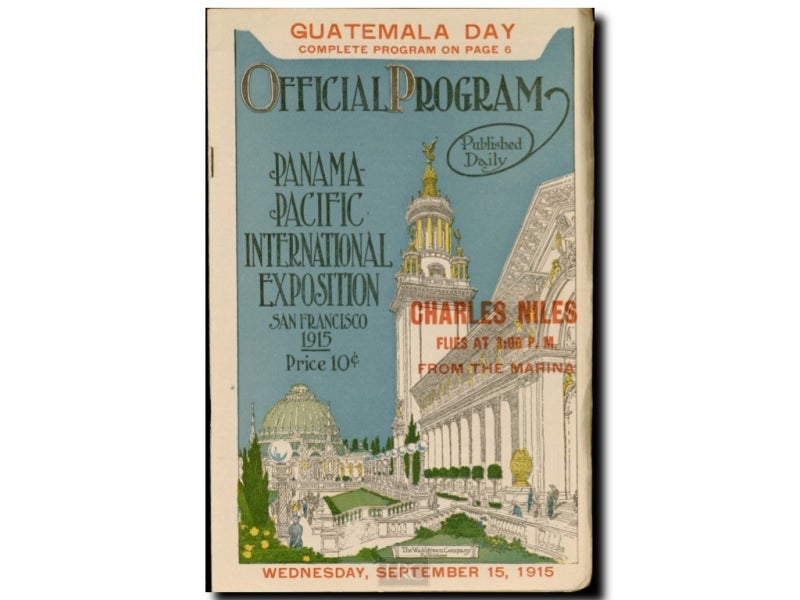
Figure 8: “Guatemala Day” Panama-Pacific Exposition, September 15th, 1915 (Cover). [Photo by courtesy of the Harry Ransom Center, the University of Texas at Austin].
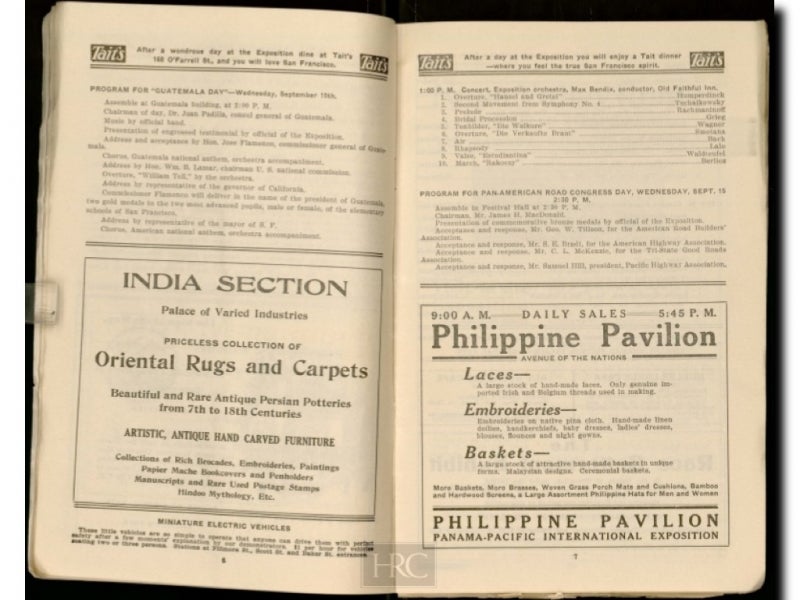
Figure 9: “Guatemala Day” Panama-Pacific Exposition, September 15, 1915 (Program details). [Photo by courtesy of the Harry Ransom Center, the University of Texas at Austin].
According to the program for “Guatemalan Day,” the marimba band played at their country’s official ceremony, along with a chorus and an orchestra. The program mentions a few musical details, like the performances of the Guatemalan and U.S. anthems, and a Rossini overture. Based on this information and the selection they recorded for Victor around that time, we might safely deduce that they mostly represented a cosmopolitan image of Guatemala by performing patriotic pieces in European styles, and pieces of European or U.S. origins (MacCallum 1969:93). (Table 2).
Table 2: Selections from the Recording Hurtado Brothers Royal Marimba Band of Guatemala (1915).16
Evidently, the Hurtados did not exclusively perform at the Guatemalan government’s request, nor always under its financial sponsorship. In an interview granted many years later, Oscar Hurtado recalled the ensemble’s performances in Vaudeville, and tells anecdotes of financial hardships. Furthermore he acknowledged that the marimbistas changed their personal appearance to attract larger audiences in the U.S. At their manager’s request, they abandoned their tuxedoes and put on an exoticist “gypsy” look by wearing Bandanas around their heads, bolero shirts and cummerbunds (Wong 1979, B-2).
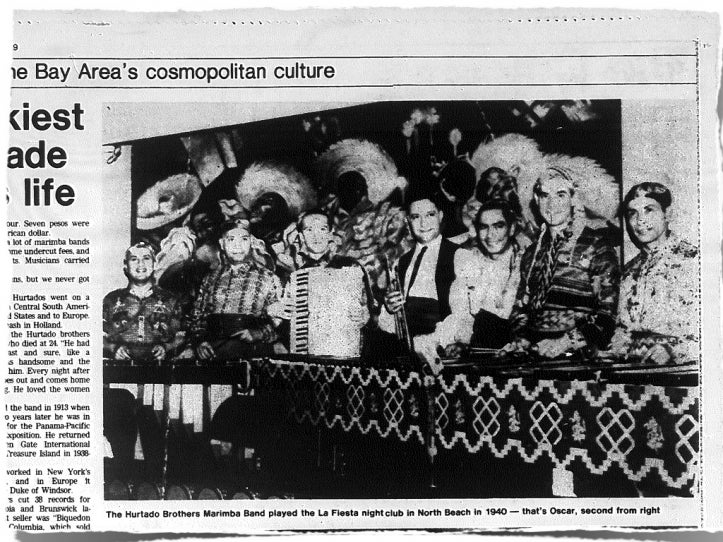
Figure 10: The Hurtado Brothers Marimba Band in the 1940s. [San Francisco Examiner's section "Heritage/A Look at the Bay Area's Cosmopolitan Culture," 1979 page B-2]
In an environment in which musicians had to negotiate their identity, one might easily envision the Hurtados also “putting on” the popular tunes, styles, and genres of the day into their repertories. Such a strategy, already suggested in their Victor recording, would present the Hurtados as exotic, and yet cosmopolitan.
The Fox Trot in Contemporary Guatemala
As ladinos continued promoting the marimba as a marker of national identity throughout the twentieth century, pieces, styles, and genres once considered fashionable and modern became canonized and nationalized. Ironically, the presentist17 framework of modernity that once gave this music value now works against it. Since airplanes and locomotives no longer symbolize cutting-edge modernity, the musical importations of the early twentieth-century now survive as modernity’s antithesis: they are now “traditional.” Interestingly, although many marimbistas feel undermined by the contemporary popular musical styles (Godínez 2002:197, 237-239), they still hold on to the hits of the past. The Smithsonian Folkways album, Marimba Chapinlandia, gives a traditional rendition of the famous fox trot “Ferrocarril de los Altos.”18
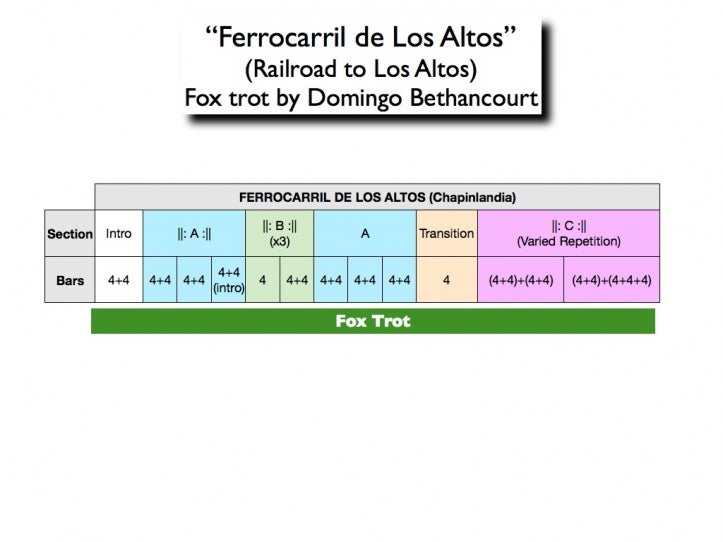
Figure 11: Phrase structure of “Ferrocarril de los Altos.” I strongly recommend you listen to the piece online while following the chart.19
As Guatemalans relegate the marimba to a “traditional” role, marimbistas look for ways to preserve its unfashionable repertoire. Marimba musician and researcher Lester Godínez has proposed that all branches of the marimba canon—namely, the folkloric, the popular (early twentieth-century), and the classical—be preserved through formal Western concert-music aesthetics and performance contexts. He designates ensembles that follow this approach “Marimbas de Concierto” or concert marimbas (Godínez 2002:239-245). The group of young marimbistas, Gaudia Cantorum, is one such ensemble. In his version of “Ferrocarril de Los Altos,” arranger and ensemble director José Domingo Velásquez seeks to update the piece.
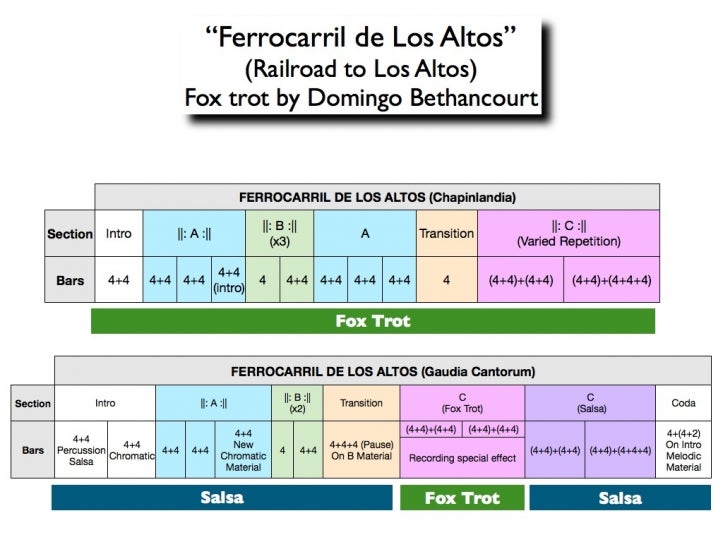
Figure 12: Phrase structure of “Ferrocarril de los Altos” in Velásquez’s arrangement. You may listen to this arrangement on the MySpace page of Gaudia Cantorum.
In this recording, Velásquez inserted background noise into the fox trot rendition of the C section, to evoke an old recording of the piece, which he then contrasts with a version of the same section updated in a salsa style.20 In an interview with musicians of Gaudia Cantorum, José Domingo explained he wants to incorporate styles which marimba ensembles have not traditionally embraced,21 and offered his opinion on the waning popularity of present-day marimba music:
It may be because the marimba music has not been updated, you see? In the heyday of the marimba, rhythms like the fox trot, the blues, and swing was the music [heard] everywhere. It was the music from the United States applied to the marimba. The marimba could have a real presence at fiestas (celebrations, dances, parties), and then when other rhythms came over, the bolero, the danzón, those tropical rhythms... even cumbia and merengue were updated to the marimba. With current music that is less melodic, like the reggaetón, this [sort of adaptation] is difficult. (personal communication, 2008)
Our discussion continued with musicians bemoaning the lack of institutional and financial support for marimba music, despite the government’s nominal recognition of its national status. As he proposed a solution to invigorate the Guatemalan marimba tradition, José Domingo showed no qualms about incorporating foreign styles. When I asked Gaudia Cantorum to comment on the apparent contradiction that Guatemala’s national music is mostly based on importations, we shared an awkward silence and uncomfortable looks before José Domingo finally said:
It’s hard to think of some rhythm that is originally Guatemalan, isn’t it? Or to make a musical insertion in the popular sphere. The marimba has [become popular] by adapting the foreign rhythms, it has done it since it became chromatic, you see? That’s how it came to be enjoyed by all people. . . . Globalization is making things difficult . . . it’s easier to grab on to what comes from outside.
This striking statement may imply that some ladinos do not consider indigenous marimba music “enjoyable by all people.” José Domingo believes, perhaps accurately, that the marimba owes its national presence to its embrace of cosmopolitan music.
Conclusion
In this paper I have attempted to incorporate evidence from ethnographic research, archival records, and musical examples to present snapshots of Guatemalan musical nationalism at various moments. In the early twentieth century ladinos promoted the marimba as an emblem of their national cosmopolitanism. At this time they incorporated foreign popular repertories like the fox trot to celebrate technological advancement, and to essentialize internal and external Others. The case of the Hurtado Brothers, who performed and recorded cosmopolitan music nationally and internationally, shows that these musicians negotiated the official nationalist representation, individual agency, and popular demand through musical practice. Additionally, recent ethnographic work demonstrates a tension between music that acquired nationalist meaning through its previous modern associations but is now unfashionable, and music that better represents the cosmopolitan attitudes of ladinos today. The fact that marimbistas negotiate between the modern and the traditional further shows that Guatemalan ladinos continue to embrace the paradigm of cosmopolitanism and modernity in their national imagination.
References:
Amado Pineda, Andrés R. 2008. “Swimming in the Musical Current: Manifestations of Cultural Agency in Young Guatemalan Marimba Ensembles.” M.A. thesis, Arizona State University.
Castro-Gómez, Santiago. 2005. “La Poscolonialidad Explicada a los Niños: Perspectivas Latinoamericanas Sobre Modernidad, Colonialidad y Geopolíticas del Conocimiento.” In La Poscolonialidad Explicada a los Niños, 11–64. Popayán: Editorial Universidad del Cauca e Instituto Pensar, Universidad Javeriana, 1–35.
Chenoweth, Vida. 1964. The Marimbas of Guatemala. Lexington, KY: The University of Kentucky Press.
Eyler, David. 1985. “The History and Development of the Marimba Ensemble in the United States and its Current Status In College and University Percussion Programs.” Ph.D. dissertation, Louisiana State University.
Gandarias, Igor de, ed. 2008. Música Guatemalteca Para Piano: Antología Histórica, Siglos XIX–XXI. Guatemala City: Universidad de San Carlos de Guatemala, Dirección General de Investigación, Centro de Estudios Folklóricos.
García Canclini, Néstor. 2005. Hybrid Cultures: Strategies for Entering and Leaving Modernity. Minneapolis: University of Minnesota Press.
Gilroy, Paul. 1993. The Black Atlantic: Modernity and Double Consciousness. Cambridge, Mass: Harvard University Press.
Godínez, Lester. 2002. La Marimba Guatemalteca: Antecedentes, Desarrollo y Expectativas (un Estudio Histórico, Organológico y Cultural). Mexico City: Fondo de Cultura Económica.
MacCallum, Frank K. 1969. The Book of the Marimba. New York: Carleton Press.
Marimba Chapinlandia. 2007. Chapinlandia: Marimba Music of Guatemala. Liner notes. Washington; Smithsonian Folkways. SFW CD 40542.
Quesada Fernández, Juan Manuel. 2008. Dante Nannini Sandoval y los Inicios de la Aviación Guatemalteca. Guatemala: Aeroclub de Guatemala.
Turino, Thomas. 2000. Nationalists, Cosmopolitans, and Popular Music in Zimbabwe. Chicago: The University of Chicago Press.
Discography:
Gaudia Cantorum, Marimba de Concierto. 2007. Alegría. CD. Guatemala City: Parroquia de la Inmaculada Concepción.
Marimba Chapinlandia. 2007. Chapinlandia: Marimba Music of Guatemala. Smithsonian Folkways. SFW CD 40542.
Archival Sources:
The University of California, Berkeley, Bancroft Library:
Wong, Ken. 1979. “World’s Luckiest Man, 83, Made Music All His Life.” The San Francisco Examiner, 14, B-2.
The University of Texas at Austin, Austin, Texas:
Guatemala. 1929. Alas: Revista Mensual de Aviación. Guatemala City: Tipografía Nacional. Benson Latin American Collection: The University of Texas at Austin.
Panama-Pacific International Exposition, Department of Fine Arts. 1915. Panama-Pacific International Official Catalogue, Illustrated. Exposition of the Department of Fine Arts. Guatemala Day Program inserted. San Francisco: Wahlgreen. Housed at the Harry Ransom Center: The University of Texas at Austin.
Museo Nacional de Arte Moderno Carlos Mérida, Guatemala City, Guatemala:
Bolaños García, Mario. n.d. Amores Chapines: Fox Trot para Piano. Score. Guatemala: [Litografía (?)] Centroamericana.
Díaz, Rigoberto. n.d. “Tud-an-Kamon: Fox Trot.” Manuscript score.
Castellanos, Rafael. n.d. “Entre las Nubes: Fox trot.” Manuscript core. Museo Nacional de Arte Moderno Carlos Mérida.
Palacios, Pedro. n.d. “Carnaval Turco: Fox Trot.” Manuscript score.
Valverde, Mariano. [1929?] “Mar y Cielo.” Score. Guatemala City: Tipografía musical Los Ecos. Autographed copy housed at the Museo Nacional de Arte Moderno Carlos Mérida. Additional copies housed at the archive of the Conservatorio Nacional de Música Germán Alcántara, Guatemala City, Guatemala.
- 1. The genres corresponding to these pieces are respectively: guaracha, corrido, bolero, fox trot, waltz, guarimba, blues, bolero, foxtrot, vals-canción, seis por ocho, son, corrido, fox-blues, bolero, fox-blues, waltz, guarimba, and mazurka
- 2. Igor de Gandarias surveyed over one thousand piano scores of the nineteenth and twentieth centuries, and observed that the number one genre in the literature was the nineteenth-century waltz, followed by the twentieth-century fox trot (de Gandarias 2008:15). Although I do not explore the relationship between piano and marimba repertoires in this paper, much of the marimba repertoire derives from piano pieces, as de Gandarias also noted (ibid., 64-66).
- 3. Although it is listed as a guarimba in the Smithsonian Folkways recording, in archival sources “Tristezas Quetzaltecas” is labeled as a fox trot. The piece, however, does not conform to the simple duple rhythm of traditional fox trots. It features instead the compound duple meter characteristic of the guarimba, a genre invented by Wotzbelí Aguilar, the composer of this piece. The discrepancy of genre attribution in this case illustrates the impact of the fox trot on locally born genres. I will further explore this impact in future work.
- 4. In this paper I use the term “ladino” as a shorthand for non-Maya, or non-indigenous. This word is analogous to the word mestizo used elsewhere in Latin America, but ladino is the more common term in Guatemala. It does not exactly correspond to mestizo since it does not exclusively refer to people of mixed European and Indigenous ancestry, although much of the ladino population fits this description. The term is much more complicated as a fluid and at times contested ethnic, racial, and cultural category of identity, which I cannot fully explicate here. I want to emphasize, however, that this paper focuses on the dominant non-indigenous conception of Guatemalan nationalism.
- 5. Turino and Castro-Gómez synthesize these characteristics of modernity based on other theorists. Turino follows Jean and John Comaroff (Turino 2000:6-7) and Castro-Gómez draws on Dussel (Castro-Gómez 2005:43-49)
- 6. This paper was originally written to be read in a twenty-minute presentation, which did not allow time for a close analysis of all these materials. I intend a more thorough presentation of them in my forthcoming dissertation. This version of the paper has been edited to fit the present format. I have kept the editing to a minimum to give a close representation of the paper as delivered at the SEM-SP conference, and as judged by the Vida Chenoweth award committee.
- 7. I do not elaborate on the transnational nature of the concept of modernity itself in this piece. Turino (2000), Gilroy (1993), García Canclini (2005), Castro-Gómez (2005) and many other authors have already explicitly or implicitly suggested this point.
- 8. According to Quesada Fernández, François Durafour flew a Deperdussin, and Paul Wyss flew a Blériot. Both came to Guatemala sponsored by the firm Farren & co. (2008:24)
- 9. By comparing the photographs to the cover page of the fox trot, it appears the airplane in the “Mar y Cielo” cover is a Ryan B5 or a Ryan B1. We might then assume that “Mar y Cielo” was written around 1929.
- 10. http://www.smithsonianeducation.org/scitech/impacto/Text2/aviation/miguel.html (accessed November 2010).
- 11. New York Times, August 1st, 1929, quoted in <http://www.smithsonianeducation.org/scitech/impacto/Text2/aviation/miguel.html>, accessed November 2010. I retain the spelling as it appears on the website.
- 12. Most Guatemalans viewed the marimba as an indigenous instrument until the late 19th century. When Guatemalan musicians built the first chromatic marimba in 1894, ladino middle classes and political elites incorporated the instrument into the national culture (Godínez 2002:121-26).
- 13. Marimbistas self promoted by incorporating the foreign music that was popular at the time, and by performing both nationally and internationally. The musical adoption of foreign music had become possible precisely because of the adaptation of the instrument itself. Quetzaltenango musicians invented the chromatic marimba near the turn of the twentieth century, to facilitate their performance of waltzes and other pieces that conform to cosmopolitan aesthetics (Chenoweth 1964:76, Godínez 2002:122-26).
- 14. They performed in honor of the birthday of president Estrada Cabrera in 1899. Chenoweth also mentions they played internationally in 1901 (1964:76).
- 15. The entire family, including members of extended family were famous marimbistas. They configured various marimba ensembles. For brevity’s sake I called the second ensemble a “second generation” although it did include at least one member of the first ensemble.
- 16. Discrepancies exist about the date of this recording. According to Eyler, the Hurtado recorded about thirty eight discs for Victor between 1915 and 1917 (Eyler 1985:40). The Library of Congress has recently published a digitized version of what I assume is the same recording cited in MacCallum (1969), and referenced here. The Library of Congress dates it as a 1916 recording. You may hear each of these tracks online, at the Library of Congress digital collection: <http://www.loc.gov/jukebox/artists/detail/id/4/>.
- 17. By presentist I mean the point tendency to judge cultures of the past by present-day standards. I’m arguing that modernity is a presentist framework, as it imposes a view of the past as “less advanced” or “less sophisticated” than the “modern now.”
- 18. This is not to say that some ensembles do not attempt to adapt to current musical developments and seek creative solutions to keep the instrument relevant. I began exploring such adaptations in my Masters’ Thesis (Amado 2008), and will continue exploring them with the historical trajectory sketched in this paper. By and large, the core repertoire of the “traditional” marimba remains rooted in early twentieth century music, as evidenced in the Chapinlandia CD, and the Teclas de Oro repertoire shown in this paper.
- 19. I strongly recommend that at this point you listen to the piece while following the form chart. Due to copyright we are not currently able to include an excerpt from Smithsonian Folkways’ Chapinlandia. However, as this is one of the most popular pieces in the Guatemalan marimba repertoire you can hear several versions of it online. Marimba ensembles will sometimes perform their own arrangements of the piece, which might change some of the repetitions and structures outlined here. The version in Chapinlandia is one of the most traditional performances of this fox trot. Among the many performances of “Ferrocarril” online, I recommend the following three that adhere closely to the table provided. The first one is by the ensemble Chapinlandia itself, at a live performance <http://www.youtube.com/watch?v=w6tgG1nMDrs>, which also shows the audience dancing. The second one is by an “ensamble de marimbas” meaning several marimba ensembles performing together. In this clip you will see more than the traditional two marimbas, 7 players, percussion, and bass that normally comprise a marimba ensemble. <http://www.youtube.com/watch?v=1Z0-1BcrnMg&feature=related>. The next example is by the Hurtado brothers <http://www.youtube.com/watch?v=LZywNg5QXy8>. All links are active as of November 2011.
- 20. See more extensive commentary on this arrangement in my Master’s Thesis (Amado 2008).
- 21. The interview took place in January 2008.




